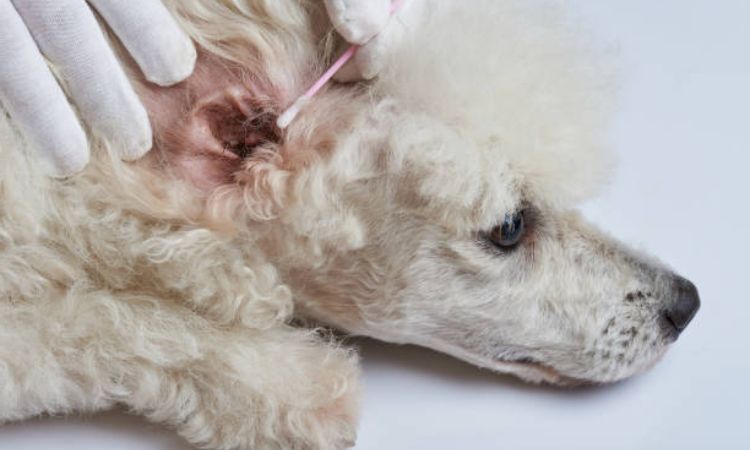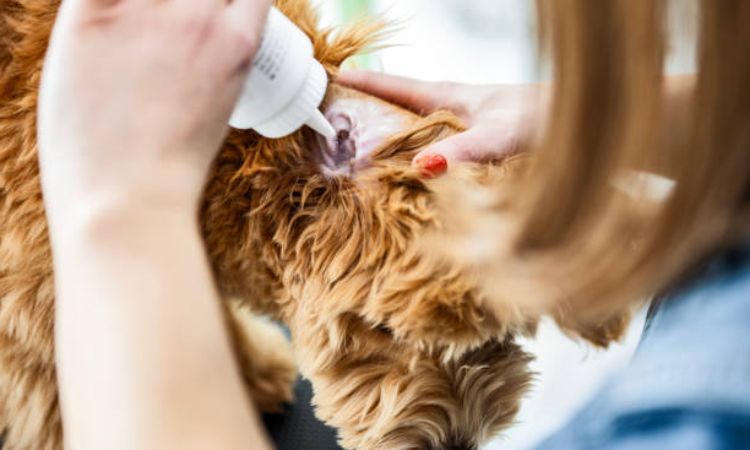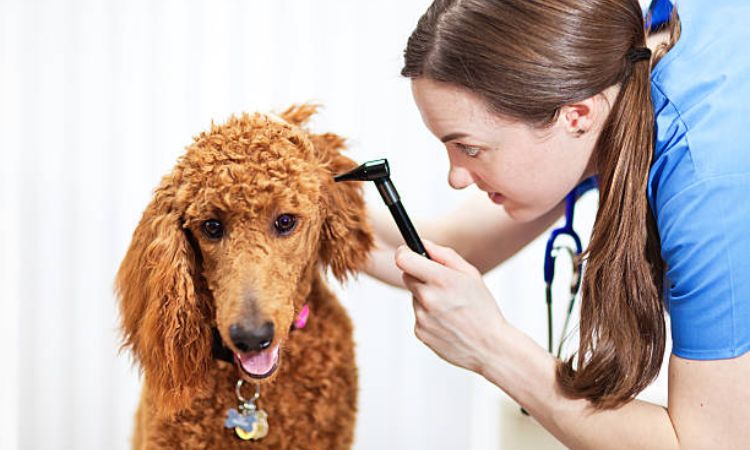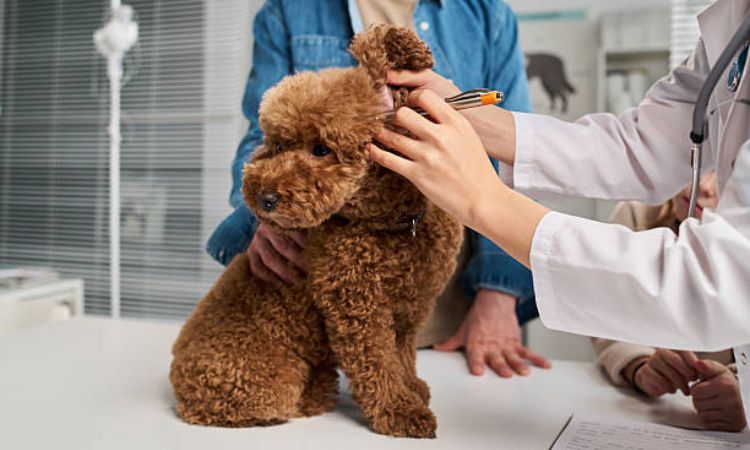Poodles are beloved for their intelligence, loyalty, and lively spirit. However, one challenge that many owners face is caring for their unique ears, which are prone to infections. With proper attention and care, you can help keep your poodle’s ears healthy and comfortable.
Today Nexus-pets will walk you through the symptoms, treatments, and prevention methods to ensure your poodle enjoys happy, healthy ears.

Symptoms of Ear Infections in Poodles
Ear infections are quite common in poodles due to their unique ear shape and thick coat. Catching the symptoms early is key to getting your dog the right treatment quickly. Watch out for these signs:
- Excessive scratching or rubbing of the ears: This usually means your poodle is feeling itchy or irritated.
- Frequent head shaking or tilting: Dogs often shake or tilt their heads to try to relieve discomfort inside their ears.
- Unpleasant odor coming from the ears: A bad smell is often caused by bacteria or yeast buildup.
- Discharge from the ear: You might notice brown, yellow, bloody, or waxy fluid coming from the ear canal.
- Redness, swelling, or inflammation: Infected ears often look red and swollen.
- Crusting or scabbing inside the ear: If the infection has been ongoing, you might see dry crusts or scabs inside the ear.
- Changes in behavior: In severe cases, your poodle may tilt their head frequently or show signs of losing balance, indicating inner ear involvement.
- Pain or sensitivity when the ear is touched: Your dog may pull away, whine, or react defensively if their ears are painful.
If you notice any of these symptoms, it’s important to visit your vet promptly to prevent the infection from worsening.
Causes and Risk Factors Specific to Poodles
Poodles have several unique traits that increase their susceptibility to ear infections. Understanding these causes and risk factors can help you better protect your dog’s ear health.
- Hair Inside the Ear Canal: The dense, curly hair growing inside a poodle’s ear canal can trap dirt, debris, and moisture. This creates an ideal environment for bacteria and yeast to multiply, increasing the risk of infection.
- Moisture Retention from Swimming or Bathing: Poodles love water, but their ear structure combined with their thick fur often traps moisture after swimming or baths. This dampness fosters bacterial and fungal growth that can lead to infection.
- Excessive Earwax Buildup: While earwax naturally protects the ear by trapping dust and debris, an overproduction can clog the ear canal. This blockage can trap moisture and microorganisms, further raising the risk of infection.
- Allergies Causing Inflammation: Food sensitivities or environmental allergens can inflame the ear canal, causing itching and irritation. This inflammation weakens the ear’s defenses and can pave the way for secondary infections.
- Environmental Factors and Foreign Bodies: Poodles’ ears can easily collect pollen, dirt, insects, or small foreign objects—especially when outdoors. These irritants can cause discomfort and trigger infections if not promptly addressed.
- Ear Mites and Parasites: Although less common, ear mites and other parasites can infest poodles, causing intense itching and secondary bacterial infections if untreated.
Besides Poodles’ floppy ears limit airflow inside the ear canal, preventing proper drying. Coupled with the dense hair around and inside the ear, this lack of ventilation promotes a warm, moist environment where infections thrive.

Diagnosing Ear Infections in Poodles
If you notice signs like head shaking, ear scratching, or unusual discharge coming from your poodle’s ears, it’s time to consult a veterinarian. Prompt diagnosis is essential to prevent the infection from worsening or causing permanent damage to your dog’s hearing.
When to See a Veterinarian
You should schedule a vet visit if your poodle shows any symptoms of an ear infection, such as persistent scratching, foul odor, redness, discharge, swelling, or signs of pain. These symptoms often point to deeper inflammation or infection that requires professional care.
What to Expect During the Exam
At the clinic, your vet will begin by performing a thorough physical examination of your dog’s ears. This usually includes:
- Visual inspection of the outer ear and ear canal to check for redness, swelling, discharge, or foreign objects.
- Otoscope examination to look deeper into the ear canal and assess the condition of the eardrum (tympanic membrane).
- Ear swab and sample collection for cytology or lab testing to determine whether bacteria, yeast, or parasites are present.
Why Eardrum Evaluation Matters
Before starting treatment, your vet must confirm that the eardrum is intact. If the eardrum is ruptured, certain medications—especially those containing specific antibiotics or cleaning agents—could cause further harm or even damage your poodle’s hearing. This step ensures that treatment is both safe and effective.
Treatment Options

Proper Ear Cleaning
Effective treatment for ear infections in Poodles begins with thorough and appropriate ear cleaning. Veterinarians typically recommend using specially formulated ear cleansers designed to break down wax, remove debris, and maintain the ear’s natural pH balance.
It’s crucial not to use cotton swabs inside the ear canal, as they can inadvertently push debris deeper or even damage the delicate eardrum. Instead, gauze or soft cloths should be used to gently clean only the visible parts of the ear, under professional guidance.
Medication-Based Treatments
Once the specific cause of the infection is identified—whether bacterial, fungal, or both—your veterinarian may prescribe targeted medications. For bacterial infections, antibiotics in the form of ear drops or oral tablets are commonly administered to eliminate harmful bacteria.
If a yeast or fungal infection is present, antifungal solutions or ointments will be necessary to address the overgrowth. In cases where swelling, redness, or discomfort is significant, anti-inflammatory medications such as corticosteroids may be prescribed to reduce inflammation and provide relief.
Addressing Underlying Causes
Beyond treating the infection itself, long-term management involves tackling any contributing factors. Allergies are a frequent culprit in Poodles, often causing chronic inflammation that leads to recurrent ear problems.
Identifying and controlling these allergies—whether food-based or environmental—is vital to preventing future episodes. If parasites such as ear mites are detected, antiparasitic treatments will be required to fully resolve the issue.
At-Home Care and Maintenance
Ongoing home care plays a pivotal role in supporting recovery and reducing the risk of reinfection. After bathing or swimming, it’s important to dry the ears thoroughly to prevent moisture buildup, which can create an ideal environment for microbial growth.
Trimming excess hair around and within the ear canal enhances airflow and reduces the chance of debris and moisture becoming trapped. Regular ear inspections, especially for Poodles with a history of infections, help detect early signs before they escalate.

Prevention Tips for Healthy Poodle Ears
Maintaining healthy ears in Poodles requires a proactive approach, especially given their floppy ears and dense hair, which can trap moisture and debris. Consistent care and early detection are key to preventing infections and ensuring long-term ear health.
- Establish a Regular Ear Cleaning Routine: Clean your Poodle’s ears regularly using a veterinarian-approved ear cleanser. This helps remove wax, dirt, and bacteria before they can lead to infection. Never insert cotton swabs into the ear canal, as this can cause injury or push debris deeper.
- Keep Ears Dry After Swimming or Bathing: Moisture is a major risk factor for ear infections. Always dry your dog’s ears thoroughly after any water exposure. You can use a soft towel and consider using ear-drying solutions recommended by your vet to remove excess moisture from the ear canal.
- Groom and Trim Hair Around the Ears: Poodles have thick hair that can grow inside and around the ear canal. Regular grooming and trimming of this hair improves airflow and reduces the chance of wax and debris becoming trapped.
- Monitor for Early Signs and Symptoms: Be alert to changes such as head shaking, ear scratching, redness, swelling, odor, or discharge. Catching problems early increases the chances of successful treatment and prevents complications.
- Manage Allergies with Veterinary Support: Allergies, whether environmental or food-related, often play a role in recurrent ear infections. Work with your veterinarian to identify and control allergic triggers, which can help prevent flare-ups in the ears.
- Schedule Routine Veterinary Ear Checks: Include ear examinations as part of your dog’s regular veterinary visits. Routine checkups can help detect problems early and allow your vet to recommend preventive care based on your Poodle’s individual needs.
Besides In especially humid environments or for water-loving dogs, consider using ear protectors or drying agents after exposure. These tools help reduce moisture accumulation and keep the ear canal dry and balanced.
By consistently implementing proactive prevention strategies and staying attentive to the earliest signs of discomfort, you can significantly reduce the risk of ear infections in your Poodle. Prioritizing their ear health ensures your beloved companion remains happy, comfortable, and full of life.






